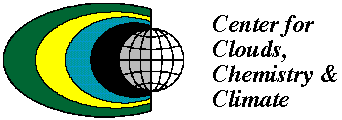
Research Achievements
Third Term Renewal Proposal,July 1, 1997 - June 30, 2002

|
Research AchievementsThird Term Renewal Proposal,July 1, 1997 - June 30, 2002 |
·
Over 40 journal papers on CEPEX related research that resulted from collaborations between C4, NOAA, NASA and DOE laboratories, US universities and German research institutions. These research papers, which was coordinated by C4, deal with the following topics: 1) atmospheric and surface energy budget; 2) vertical water vapor distribution and greenhouse effect; 3) cirrus microphysical properties; 4) assessment of hypotheses for SST regulation, including the cirrus thermostat; 5) near zero ozone concentration in convective regions of the Pacific; 6) GCM development and validation; and 7) excess solar absorption.·
A significant improvement in the NCAR-CCM3 simulation of the tropical climate including surface evaporation, cloud-radiation interactions and the Indian monsoon. This joint C4 NCAR effort resulted primarily from CEPEX-TOGA/COARE data and related research. Our significant success in improving the CCM fits well with the USGCRP paradigm of observations, leading to analysis and understanding, leading to improved predictive modeling and benefits to society.·
Successful development of the Model of Atmospheric Transport and Chemistry (MATCH) for simulating the tropospheric ozone distribution in the pristine tropical Pacific. This important NCAR-MPI-C4 modeling initiative was motivated by the unexpected discovery from CEPEX that near zero ozone concentrations occur within the upper troposphere of convective regions in the tropical Pacific.·
The finding of excess solar absorption in the warm pool clouds, i.e., clouds enhance significantly atmospheric solar absorption, when compared with the clear skies. This serendipitous CEPEX result has started a large national and international effort for understanding the absorption of solar radiation in cloudy atmospheres.·
Development of the international and US component of the INDOEX field program dealing with interactions between clouds, aerosols, chemistry and climate in the Indian Ocean. C4 is the coordinator for this program, in which over 40 research institutions in the US, Germany, France, India and Netherlands will participate. C4 Home Page
C4 Home Page